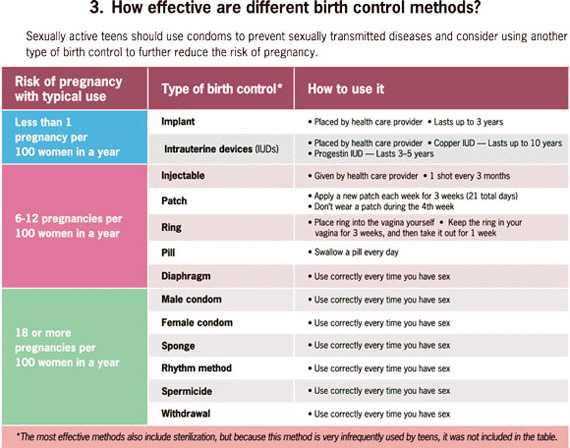Preventing Repeat Teen Births
On This Page
April 2013


 1 in 5
1 in 5
Nearly 1 in 5 births to teen mothers, ages 15 to 19, is a repeat birth*.
 183
183
About 183 repeat teen births occur each day in the US.
 1 in 5
1 in 5
About 1 in 5 sexually active teen mothers use the most effective types of birth control after they have given birth.
Although teen birth rates have been falling for the last two decades, more than 365,000 teens, ages 15–19, gave birth in 2010. Teen pregnancy and childbearing can carry high health, emotional, social, and financial costs for both teen mothers and their children. Teen mothers want to do their best for their own health and that of their child, but some can become overwhelmed by life as a parent. Having more than one child as a teen can limit the teen mother's ability to finish her education or get a job. Infants born from a repeat teen birth are often born too small or too soon, which can lead to more health problems for the baby.
Repeat teen births can be prevented.
Health care providers and communities can:
- Help sexually active teen mothers gain information about and use of effective types of birth control.
- Counsel teens that they can avoid additional pregnancies by not having sex.
- Connect teen mothers with support services that can help prevent repeat pregnancies, such as home visiting programs.
*A repeat teen birth is the 2nd (or more) pregnancy ending in a live birth before age 20.
Problem
Too many teens, ages 15–19, have repeat births.
Nearly 1 in 5 births to teens, ages 15–19, are repeat births.
- Most (86%) are 2nd births.
- Some teens are giving birth to a 3rd (13% of repeat births) or 4th up to 6th child (2% of repeat births).
- American Indian and Alaskan Natives, Hispanics, and black teens are about 1.5 times more likely to have a repeat teen birth, compared to white teens.
- Infants born from a repeat teen birth are often born too small or too soon, which can lead to more health problems for the baby.
Working together, a sexually active teen and her doctor or other health care professional can decide on the best birth control method.
- More than 9 in 10 (91%) sexually active teen mothers used some form of birth control, but only about 1 in 5 (22%) used the most effective types of birth control.
- White (25%) and Hispanic (28%) teen mothers are almost twice as likely as black teen mothers (14%) to use the most effective types of birth control.
- Long-acting reversible birth control can be a good option for a teen mother because they do not require her to do something on a regular basis – such as take a pill each day.
- Hormonal implants and IUDs are two types of long-acting reversible birth control. These are some of the most effective forms of birth control.

SOURCE: National Vital Statistics System, teens, ages 15–19, 2010

SOURCE: National Vital Statistics System, teens, ages 15–19, 2010

SOURCE: Adapted from Trussell J in Contraceptive Technology, 2011, and FDA Office of Women’s Health Birth Control Guide
What Can Be Done
Federal government is
- Funding states and tribes through the Pregnancy Assistance Fund to provide pregnant and parenting teens with a complete network of support services.
- Promoting home visiting and other programs shown to prevent repeat teen pregnancy and reduce sexual risk behavior.
- Conducting and evaluating programs that work, as well as innovative approaches to reduce teen pregnancy and births in communities with the highest rates.
- Helping other groups with information to duplicate teen pregnancy prevention programs that have been shown to be effective through rigorous research. http://www.hhs.gov/ash/oah/oah-initiatives/tpp/tpp-database.html
Doctors, nurses, and other health care professionals can
- Discuss with sexually active teens the most effective types of birth control to prevent repeat pregnancies. Refer to CDC guidelines: http://www.cdc.gov/reproductivehealth/unintendedpregnancy/USMEC.htm
- Counsel parenting teens on how they can avoid additional pregnancies by not having sex.
- Advise teen mothers that births should be spaced at least 2 years apart to support the health of the baby, and that having more than one child during the teen years can make it difficult for teen parents to reach their educational and work goals.
- Remind sexually active teens to also use a condom every time to prevent sexually transmitted diseases, including HIV/AIDS.
Parents, guardians, and caregivers can
- Talk about how to avoid repeat births with both male and female teens. http://www.cdc.gov/teenpregnancy/parents.htm
- Check with your insurer about coverage of preventive services. In some cases, preventive services, such as birth control methods and counseling, are available with no out-of-pocket costs.
- Talk with community leaders, including faith-based organizations, about using effective programs that can help prevent repeat teen pregnancies.
All teens, including teen parents, can
- Choose not to have sex.
- Use birth control correctly every time if they are having sex. Use condoms every time to prevent disease.
- Discuss sexual health issues with their parents, partner, health care professionals, and other adults and friends they trust.
- Visit http://www.hhs.gov/opato find a family planning clinic near them for birth control if they choose to be sexually active.
Science Behind the Issue
Related Pages
- Vital Signs Issue details: Repeat Births Among Teens — United States, 2007–2010, Morbidity and Mortality Weekly Report (MMWR)
- CDC Feature – Breaking the Cycle of Teen Pregnancy
- Vital Signs – Preventing Repeat Teen Births [PODCAST – 01:15 seconds]
- Vital Signs – Preventing Repeat Teen Births [PSA – 0:60 seconds]
On Other Web Sites
- Page last reviewed: April 2, 2013
- Page last updated: April 2, 2013
- Content source:
- National Center for Chronic Disease Prevention and Health Promotion, Division of Reproductive Health
- Page maintained by: Office of the Associate Director for Communications (OADC)


 ShareCompartir
ShareCompartir